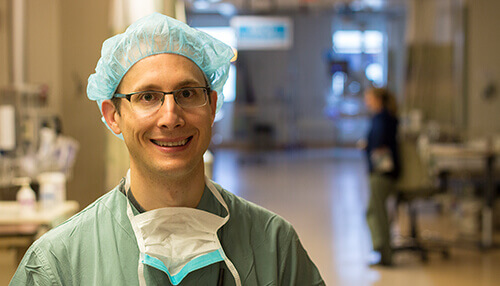Dr. Thomas Mutter

Preparing Manitobans for surgery requires interdisciplinary collaboration. In addition to a surgeon, most surgical patients will also receive care from an anesthesiologist, a primary care provider and a preanesthetic clinic. Historically, panels of blood work and other investigations like electrocardiograms and chest x-rays were ordered routinely. They were intended to screen for asymptomatic abnormalities and/or to use normal results to demonstrate that the patient was ready for surgery and anesthesia.
Just as in other areas of clinical care where Choosing Wisely recommendations have shown to add value to patient care, we’ve also learned that more is not always better when it comes to preoperative testing. It is uncommon for asymptomatic patients to have abnormalities in their preoperative tests, and the abnormalities we do find rarely result in significant changes in clinical care. Conversely, false positive tests can lead to more invasive and unnecessary confirmatory testing that may have other adverse effects for the patient. With no evidence to suggest that this screening improves outcomes, additional testing can lead to surgery delays, potentially causing stress to the patient and progression of the underlying disease.
Since 2015, our team has been working to help physicians and other caregivers choose preoperative testing wisely. With support from Manitoba Health, the George and Fay Yee Centre for Health Care Innovation and leadership from all the disciplines regularly involved in preoperative care, we have successfully taken steps towards improving preoperative diagnostic testing .One of our first steps was to incorporate the Canadian Anesthesia Society’s Choosing Wisely recommendations on preoperative testing into a provincial preoperative testing guideline. These recommendations have been shown to significantly reduce the amount of recommended laboratory testing prior to elective surgery compared to what has historically been obtained. We also recognized that on its own, dissemination of this guideline would not be sufficient to significantly and sustainably change practice. We were particularly aware that in the multidisciplinary preoperative environment patients and providers would continue to be inconvenienced by requests for unnecessary testing unless all team members consistently adhered to the guideline. Furthermore, we were concerned that inconsistent adherence would lead to confusion between providers and a fall back to routine ordering of panels of preoperative lab work in a misguided attempt to more efficiently move the patient through the system.
Considering these challenges, our team has worked hard to ensure that anesthesiologists and preanesthetic clinics, as the last team members to see the patient before surgery, are up-to-date on this culture practice change. In addition, we’ve created a variety of knowledge translation tools including an updated preoperative history and physical form, an online app with guideline content and template letters for communication of preoperative testing expectations and other information between surgeons and primary care providers. A recently completed chart audit has shown that these initiatives were associated with a 34% reduction in unnecessary testing, and an estimated savings of $32 per patient, or approximately $900,000 per year within the Winnipeg Regional Health Authority. We’re optimistic that we can achieve further improvements in preoperative testing by further engaging stakeholders with additional knowledge translation strategies.
